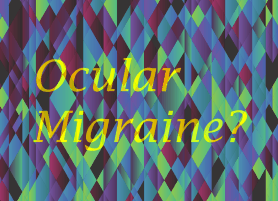Ocular Migraine Symptoms
Discussing ocular migraine symptoms can be frustrating because the term itself remains confusing. The International Headache Society has provided guidance in the diagnosis of migraine conditions and symptoms through their “International Classification of Headache Disorders”, which lists various types of headache and migraine disorders. But ocular migraine isn’t one of them.
 So if your doctor is using the term, I would encourage them to refer to the classification system, which will help us all speak the same language!
So if your doctor is using the term, I would encourage them to refer to the classification system, which will help us all speak the same language!
Types of “Ocular Migraine”
Today, people who are talking about ocular migraine symptoms are typically referring to some type of migraine with aura (yes, there are many types!). But first let’s take a look at the warning symptoms, because visual symptoms can be a sign of various conditions. If you’re having vision problems, and any of the below describes you, see a doctor immediately.
Warning signs:
- Visual symptoms last for less than 5 minutes.
- Visual symptoms last more than an hour.
- Symptom is primarily partial or complete blindness (as opposed to seeing flashing lights, etc).
- You have recently had a stroke or brain injury.
- The symptoms are new – this is especially a concern if you are over 40.
Even if none of the above is true, if these are new symptoms to you, you should see a doctor. Issues such as transient ischemic attack (TIA) (mini-stroke) and even stroke can closely mimic migraine. Your doctor will need to rule out other conditions before giving you a diagnosis.
Now you’re still experiencing ocular migraine symptoms, and you want to narrow down your diagnosis some more. This will help.
What type of migraine?
- Are you experiencing “motor weakness” along with the visual symptoms? Motor or muscle weakness may be a sign that you’re suffering from a type of hemiplegic migraine.
- Are you experiencing other strange symptoms, such as jerky movements, trouble speaking, trouble hearing, vertigo, double vision, or even a decreased level of consciousness? Some of these may be typical of migraine with aura, but they could indicate migraine with brainstem aura.
- Is the aura strictly visual, and it’s happened several times? Do the visual symptoms always last between 5 minutes and 1 hour? And are they always in only one eye? If so, you may have retinal migraine.
If none of these fit you, you may have typical migraine with aura.
Now, you’ll notice I didn’t say a lot about headaches. Yes, it is common to have headaches along with retinal migraine – but it’s not always the case. It is possible to have retinal migraine attacks with no headache. It is also possible to have typical aura without headache, which is more common and can have more varied symptoms than the more specific retinal migraine.
Underneath many of these types of migraine, there are also sub-types.
If you’re wondering if it’s worth getting a specific diagnosis for your ocular migraine symptoms, it is. Some of these types of migraine have treatments that specifically work with that migraine type.
A neurologist with experience in migraine and headache conditions can help you find a diagnosis and a treatment.
The Mayo Clinic has a brief but helpful article on ocular migraine symptoms here.
Again, if these are new symptoms, you should go to a doctor who can help you rule out various other possibilities. Whether migraine or not, these can be serious and debilitating symptoms.
